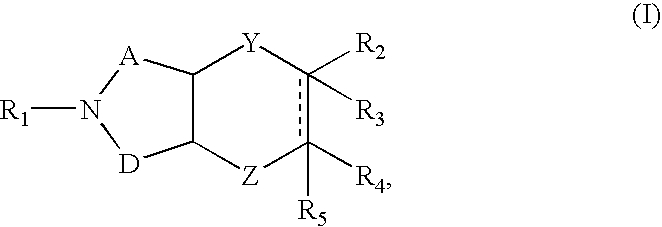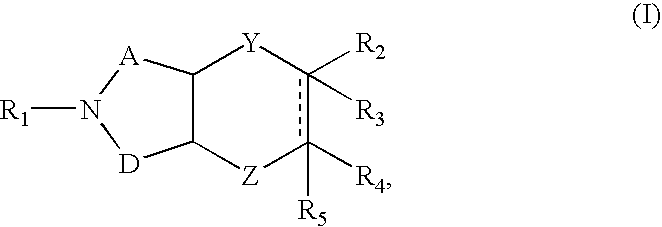Azabicyclic compounds are central nervous system active agents
a technology of azabicyclic compounds and central nervous system, which is applied in the field of azabicyclic compounds and a method for treating pain in mammals, can solve the problems of low clinical efficacy, low clinical efficacy, and low efficacy of azabicyclic compounds in relieving severe or chronic neuropathic pain
- Summary
- Abstract
- Description
- Claims
- Application Information
AI Technical Summary
Benefits of technology
Problems solved by technology
Method used
Image
Examples
example 1
(cis)-5-(6-chloro-3-pyridinyl)-1,2,3,3a,4,6a-hexahydrocyclopenta[c]pyrrole hydrochloride
example 1a
(cis)-2,3,3a,4,7,7a-hexahydro-1H-isoindole
[1267]A suspension of lithium aluminum hydride (21.4 g, 0.562 mol) in THF (700 mL) at room temperature was treated with cis-1,2,3,6-tetrahydrophthalimide (Aldrich; 37 g, 0.245 mol) in small portions. The reaction mixture was stirred at 60° C. overnight then cooled to room temperature and quenched carefully by the sequential addition of water (22 mL), THF (22 mL), 15% aqueous KOH (22 mL), and water (80 mL). The mixture was diluted with diethyl ether (100 mL), stirred at room temperature for 1 hour, and then filtered (methylene chloride wash). The filtrate was concentrated under reduced pressure to provide the title compound as an oil (26.1 g). 1H NMR (CDCl3, 300 MHz) δ 1.76–2.02 (m, 2H), 2.10–2.33 (m, 3H), 2.34–2.56 (m, 2H), 2.61–2.79 (m, 2H), 2.87–3.17 (m, 2H), 5.53–6.03 (m, 2H); MS (DCI / NH3) m / z 124 (M+H)+.
example 1b
tert-butyl (cis)-1,3,3a,4,7,7a-hexahydro-2H-isoindole-2-carboxylate
[1268]The product from Example 1A (26 g, 0.21 mol) in methylene chloride (250 mL) at 0° C. was treated with di-tert-butyl dicarbonate (46.1 g, 0.21 mol). The solution was stirred for 30 minutes at 0° C. and then 2 hours at ambient temperature. The reaction mixture was partitioned between methylene chloride and saturated aqueous sodium bicarbonate. The organic extract was washed with saturated aqueous sodium bicarbonate and brine, dried over Na2SO4, filtered and the filtrate was concentrated under reduced pressure. The residue was purified by chromatography (SiO2, 15% ethyl acetate / hexane) to provide the title compound (36 g). 1H NMR (CDCl3, 300 MHz) δ 1.45 (s, 9 H), 1.84–1.99 (m, 2H), 2.11–2.40 (m, 4H), 3.07 (m, 1H), 3.18 (m, 1H), 3.33–3.53 (m, 2H), 5.60 (bs, 2H); MS (DCI / NH3) m / z 224 (M+H)+.
PUM
| Property | Measurement | Unit |
|---|---|---|
| pH | aaaaa | aaaaa |
| volume | aaaaa | aaaaa |
| temperature | aaaaa | aaaaa |
Abstract
Description
Claims
Application Information
 Login to View More
Login to View More - R&D
- Intellectual Property
- Life Sciences
- Materials
- Tech Scout
- Unparalleled Data Quality
- Higher Quality Content
- 60% Fewer Hallucinations
Browse by: Latest US Patents, China's latest patents, Technical Efficacy Thesaurus, Application Domain, Technology Topic, Popular Technical Reports.
© 2025 PatSnap. All rights reserved.Legal|Privacy policy|Modern Slavery Act Transparency Statement|Sitemap|About US| Contact US: help@patsnap.com



